
1997 Proceedings
1997 Photos
 1997 Proceedings 1997 Photos |
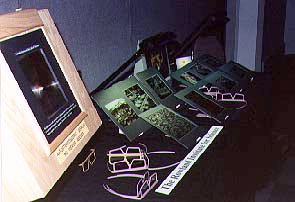
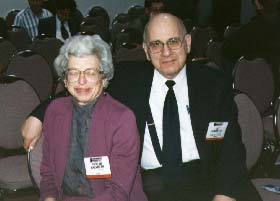
The Rowland Institute for Science (Cambridge MA) displayed their full colour vectographs generated using a standard ink jet printer loaded with special inks. Linearly polarised 3D glasses are worn to view the 3D image. They also displayed an autostereoscopic image (left) which I think is based on a parallax barrier technique. In the second picture are Vyvian Walworth and Jay Scarpetti from the Rowland Institute for Science.
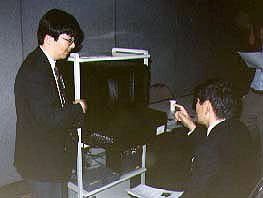
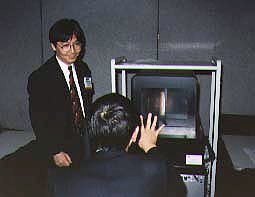
An autostereoscopic display from the Advanced 3D Telecommunications Project, Shinagawa Research Centre, Japan was demonstrated by Yoshi Kajiki (left).
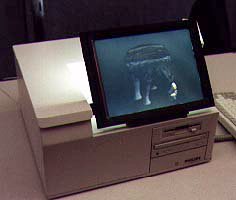
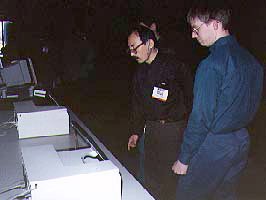
Cees van Berkel displayed the Multi-view (Autostereoscopic) 3D LCD displays from Philips Research Laboratories. Their display is unique in that the lenticular lenses are offset slightly from vertical - this allows and interesting compromise between resolution and the number of viewing zones. (At right are Shojiro Nagata and Neil Dodgson).
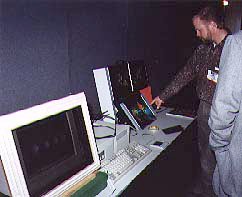
David Mark displayed images of space and minerals in support his presentation earlier on that day. The space images were shown on a computer display and viewed with circularly polarised glasses (which work in combination with the liquid crystal modulator - available from NuVision (Beaverton OR)). The mineral images were autostereoscopic and were either parallax barrier or lenticular. At right is John Miller ("look Mum, it's in 3D!").
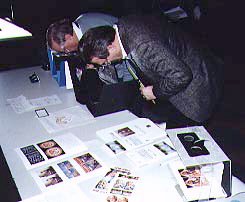
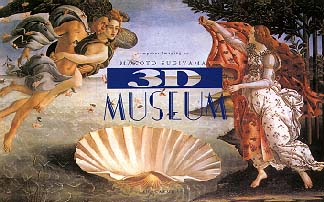
Shojiro Nagata displayed two books based on 3D images created by computer artistSugiyama Makoto. The first book (bottom right of left image, and right image) is titled "3D Museum" and is published by Shogakukan Publishing of Japan and uses an interesting inbuilt lensed viewer to view the stereo pairs. The second book is titled "3D Classic Pictures" and is published by ThinkLab Inc of Japan. This book uses a mirrored viewer to view the stereopair images as is being demonstrated by Lowell Noble and Steve Aubrey.
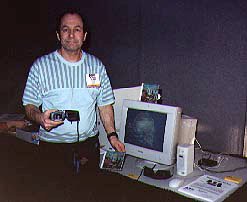
Michael Starks demonstrated a range of software and hardware available from 3DTV Corporation.
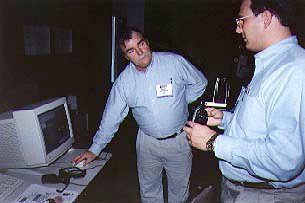
On display from StereoGraphics Corporation were (at left) the CrystalEyes 3D Video system (if you look close at the screen you may be able to make out Jay Scarpetti and Lenny Lipton - OK, Jay and Lenny may be the only ones to recognize themselves...) and (at right) Bruce Dorworth gives an on-line demonstration of stereoscopic images over the World Wide Web using the "Simuleyes VR" liquid crystal shutter glasses.
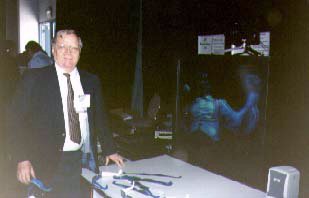
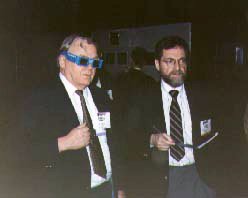
Lowell Noble from QD Technology displays the desktop model of the "3D Black Screen" 3D rear screen video projection display (how's that for a mouth full). It's viewed with circularly polarised 3D glasses. At right: Lowell Noble and Lenny Lipton.
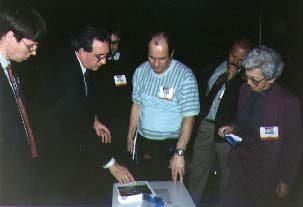
In addition to the hardware demonstrations, 3D videos and 3D slides were shown in the separate screening room. This photo shows a number of people deep in discussion after one of the screenings. From left: Mathius Hammer, John Merritt, Cees van Berkel, Michael Starks, John Miller and Vyvian Walworth.
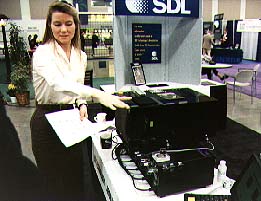
Elizabeth Downing displayed her volumetric display. The system uses a specially doped crystal into which two IR lasers are directed. The point at which the lasers intersect causes a point of light. A volumetric image is created by directing the point of intersection around inside the cube to trace the image to be created.

The Turing Institute displayed a system called C3D which allowed the three dimensional shape of a person's face to be digitized. The system used a pair of video cameras and a slide projector. The system would project a random pattern onto the person's face - presumably to provide sufficient features on the persons face to allow a three dimensional reconstruction to be done. The system would then take a normal image of the person's face to obtain the texture map. The person would then walk away with a floppy disk containing all that information. Unfortunately I didn't have time to have this done.
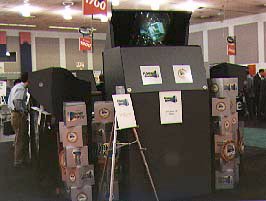
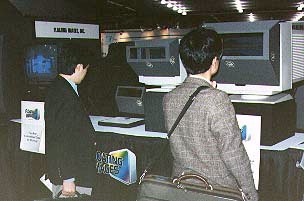
Floating Images displayed a system, which although not strictly a stereoscopic display, can be used to create a three dimensional image. By the use of a beam splitter and mirror, two image planes are displayed at different depths. A text display could be shown on the front image plane and a TV image shown on the rear image plane but with judicious use of the image planes and the images shown on them, a seemingly three dimensional image is seen (even though only two depth planes are used). A full description of the system appears in Gene Dolgoff's paper in the Stereoscopic Displays & Virtual Reality Systems IV proceedings.
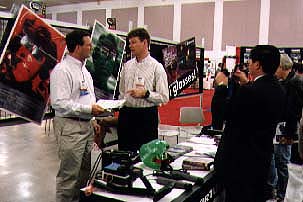
Virtual i-O and D3P Multidimensional Media shared a stand on the exhibition floor. Virtual i-O displayed their head mounted displays including their new VGA resolution (640x480) HMD. D3P displayed their various stereoscopic camera systems and also their new video tape titled Escape.
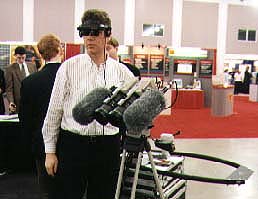
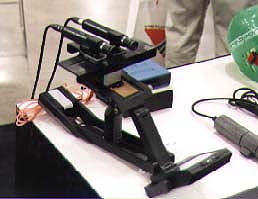
The first image above shows Craig Adkins demonstrating his professional stereoscopic camera system and the second image shows another stereoscopic camera which uses a pair of XC999 video cameras mounted on a steadycam junior.
All photographs (except 3DMuseum cover) © 1997 Andrew Woods.
